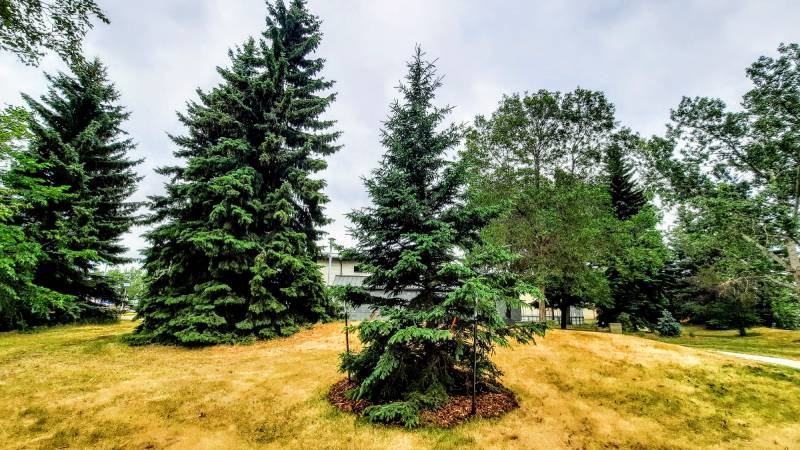Program Steps
Citizens interested in donating a privately-owned tree for planting on public property are required to submit a proposal. Each proposal must include:
- Detailed information about the privately-owned tree including species, approximate height, DBH (diameter at breast height), and overall condition.
- Indication and distance from surrounding infrastructure including sidewalks, driveways, landscaping stones, etc. A 2.4m radius of clearance around the tree is required. The tree should not be fenced in.
- A photo of the privately-owned tree to be donated and its surroundings.
- An initial utility locate request from Alberta One-Call and Shaw should be supplied by the potential donor.
To request a Tree Donation application form, please email communityforestry@edmonton.ca.
When tree donation requests are made, an Urban Forester must assess the feasibility of the privately-owned tree and site. Foresters consider the following guidelines when reviewing your proposal:
- To maximize the prospects of a successful transplant, a maximum of 20 tree donations will only be accepted annually. A total of 10 trees will be transplanted in the spring and 10 trees in the fall.
- The suitability of tree species: Poplars, Manitoba maples, fruit-bearing trees, shrubs, cedars, and junipers will not be considered as they are maintenance-heavy as they mature. Other species considered invasive will also not be accepted.
- Trees must have good form with a strong single leader, good branch and root structure.
- Trees must be in good health with vigorous growth of leaves/buds, no wounds, no diseases or pests.
- Coniferous trees must be over 2.5 metres in height.
- The minimum accepted Diameter at Breast Height (DBH) is 8 cm and the maximum is 20 cm.
- Please refer to How to Measure a DBH for further instruction.
- The privately-owned tree will be moved via a tree-spade, usually attached to heavy equipment like a skid-steer. Therefore, the following site factors must also be considered:
- There must be clear access to the privately-owned tree. Permanent fences and landscaping can be a barrier and the equipment will not cross private pavement, such as a driveway or walkway, due to possibility of damage caused by heavy equipment.
- There must be sufficient clearance from adjacent landscaping, pavement, and private property to allow room for the tree-spade.
- An underground utility check must be completed to ensure that there will be no conflicts with the tree-spade as it digs the tree.
If the proposal is approved, the Urban Forester will find a suitable park space nearby that could accommodate the donated tree. Trees will be planted in accordance with the City’s Design and Construction Standards and the citizen will be required to sign a Consent Form with the City which states:
- The Forester will coordinate and schedule the relocation of the tree with a contractor and apprise the property owner of the scheduling.
- The Forester will conduct a One-Call and DigShaw locate and circulate the proposed relocation to external and internal stakeholders for approval.
NOTE: Using a tree-spade for transplant means that the hole at the former location of the tree on private property will be filled by a plug from the park space the tree is heading to. This means that the former tree spot may not be perfectly even and the top of the plug may not match its new surroundings.
Once the tree is relocated, it will be entered into City inventory. This means:
- The tree is now considered a City asset.
- The tree will become the responsibility of the City and all future maintenance, such as watering, fertilizing, pruning, will be completed by the City.
- The citizen will no longer complete any form of maintenance on the tree.
- Should a situation arise where the tree is in conflict with repair or maintenance of public property, the City reserves the right to remove any plant material.


